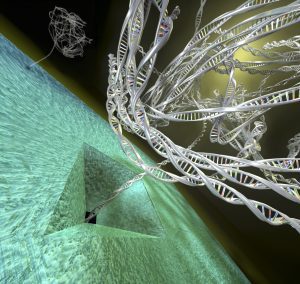Genetics, the study of heredity and variation in living organisms, has long been a cornerstone of biological sciences. However, it is through the lens of biophysics that we can truly unravel the intricate mechanisms underlying genetic phenomena. In this article, we delve into the fascinating intersection of biophysics and genetics, exploring how the physical principles of nature govern the code of life.
Introduction to Genetics
Genetics is the study of genes, DNA, and heredity in living organisms. It encompasses a wide array of phenomena, from the inheritance of traits to the mechanisms of evolution. At its core, genetics seeks to understand how information encoded in DNA is translated into the diverse array of traits observed in organisms.
Understanding Biophysics
Biophysics is the interdisciplinary field that applies the principles of physics to biological systems. It explores the physical properties of biomolecules, cellular structures, and biological processes, shedding light on the fundamental mechanisms that govern life.
The Interplay of Biophysics and Genetics
DNA Structure and Function
Central to genetics is the molecule DNA (deoxyribonucleic acid), which serves as the blueprint for life. Biophysical techniques have been instrumental in elucidating the structure of DNA, revealing its double-helix configuration and the precise manner in which it stores genetic information.
Biophysical Mechanisms in Genetic Regulation
Genetic regulation, the process by which genes are turned on or off, is governed by intricate biophysical mechanisms. From the bending and looping of DNA to the binding of regulatory proteins, biophysics plays a crucial role in modulating gene expression.
Genetic Variation and Evolution

Biophysical Influences on Genetic Variation
Genetic variation, the diversity of genetic material within a population, arises from a myriad of biophysical factors. Mutations, genetic recombination, and epigenetic modifications are all influenced by the physical properties of DNA and its interactions with the cellular environment.
Evolutionary Implications of Biophysics in Genetics
Biophysical processes shape the course of evolution by influencing the dynamics of genetic variation. Natural selection acts upon heritable traits, driving the adaptation of organisms to their environment based on biophysical constraints and opportunities.
Biophysical Insights into Disease Genetics
Understanding the biophysical basis of genetic diseases is essential for developing effective diagnostic and therapeutic strategies. Biophysical techniques such as X-ray crystallography and nuclear magnetic resonance spectroscopy have enabled researchers to unravel the molecular basis of genetic disorders.
Therapeutic Approaches Informed by Biophysics
Biophysical principles inform the development of novel therapeutic interventions, from gene editing technologies to precision medicine. By targeting specific biophysical properties of biomolecules, researchers can design more effective treatments for a wide range of genetic conditions.
Future Directions and Research
Emerging Technologies in Biophysics and Genetics
Advances in biophysics and genetics are paving the way for groundbreaking discoveries and technological innovations. From single-molecule imaging techniques to computational modeling approaches, new tools are revolutionizing our understanding of the code of life.
Ethical Considerations and Challenges
As biophysical techniques continue to advance, ethical considerations surrounding genetic manipulation and privacy become increasingly important. Balancing scientific progress with societal values requires careful deliberation and proactive engagement with stakeholders.
Conclusion
In conclusion, the integration of biophysics and genetics offers a powerful framework for deciphering the complexities of nature’s code. By elucidating the physical principles underlying genetic phenomena, we gain deeper insights into the fundamental mechanisms of life and open new avenues for medical innovation and ethical exploration.
FAQs
How does biophysics contribute to our understanding of genetic diseases?
Biophysics provides valuable insights into the molecular mechanisms underlying genetic diseases. By studying the physical properties of biomolecules involved in disease processes, researchers can uncover the root causes of genetic disorders and develop targeted therapeutic strategies.
What role does DNA structure play in genetic regulation?
The structure of DNA plays a crucial role in genetic regulation by dictating how genes are accessed and expressed. DNA packaging, chromatin remodeling, and protein-DNA interactions all influence gene expression, highlighting the importance of DNA structure in controlling cellular processes.
How do biophysical techniques inform evolutionary biology?
Biophysical techniques enable researchers to study the physical properties of biomolecules and their interactions within living systems. By understanding how these biophysical factors shape genetic variation and evolutionary processes, scientists can unravel the mechanisms driving species diversification and adaptation over time.












